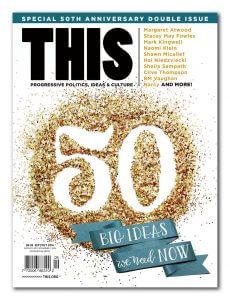What are Canadians missing about Indigenous men?
We are finally having conversations about Indigenous women. Now, we need to talk about men.
Kim Anderson
 For our special 50th anniversary issue, Canada’s brightest, boldest, and most rebellious thinkers, doers, and creators share their best big ideas. Through ideas macro and micro, radical and everyday, we present 50 essays, think pieces, and calls to action. Picture: plans for sustainable food systems, radical legislation, revolutionary health care, a greener planet, Indigenous self-government, vibrant cities, safe spaces, peaceful collaboration, and more—we encouraged our writers to dream big, to hope, and to courageously share their ideas and wish lists for our collective better future. Here’s to another 50 years!
For our special 50th anniversary issue, Canada’s brightest, boldest, and most rebellious thinkers, doers, and creators share their best big ideas. Through ideas macro and micro, radical and everyday, we present 50 essays, think pieces, and calls to action. Picture: plans for sustainable food systems, radical legislation, revolutionary health care, a greener planet, Indigenous self-government, vibrant cities, safe spaces, peaceful collaboration, and more—we encouraged our writers to dream big, to hope, and to courageously share their ideas and wish lists for our collective better future. Here’s to another 50 years!
Last summer, I saw something on my university campus that stopped me dead. It was a larger-than-life, freshly erected, bronze statue of Sir John A. Macdonald holding out two empty chairs, provocatively entitled “A Canadian Conversation.” Given the suffocating, lethal failure of Sir John to converse with my Cree and Métis ancestors, I decided it was time to sit in. With a colleague, I dressed up in a jailbird outfit and settled into those chairs. I saw it as part of our job as Indigenous historians—to make the invisible apparent.
Indigenous invisibility is the outcome of a ubiquitous terra nullius/empty land narrative—a “vast wilderness” that underpins such alluring slogans as “yours to discover.” This empty land requires ongoing Indigenous disappearance. Indigenous content is largely absent from the Canadian school curriculum, and sub-standard education for Indigenous children means they go missing from institutions of higher education. Then there are the Indigenous people who continue to disappear into the jails or through suicides—or off the streets or highways, as we have seen with the staggering numbers of missing and murdered Indigenous women.
The good news is that there is now increasing public discourse on “truth and reconciliation,” and the Canadian state is finally paying attention to the disappearance of Indigenous women and girls. But what are we missing when it comes to Indigenous men? After decades of work on the health and well-being for Indigenous women and children I have started to explore Indigenous masculinities. I’d therefore like to introduce a conversation about Indigenous men in Canada’s stories, past and future.
In the tradition of gendered nationalist narratives, Canada maintains its share of typical heroes. Indigenous peoples are visible only when they play supporting characters in stories of the triumphant white heteropatriach; Indigenous women, as imperial booty and access points into the lands and men that stand in the way. When wilderness isn’t enough of an opponent, the frontier hero gains leadership, lands, and settler entitlement by beating the savage, or sometimes “going Native”—either way, this inevitably involves erasure for Indigenous men.
If you think this narrative is outdated, consider how in Justin Trudeau’s recent celebrity boxing match, which played up his white gentlemanly self, Trudeau punched out the savage “Algonquin Agitator,” Senator Patrick Brazeau. Then, in a move astonishingly familiar to the first act of abuse perpetrated in residential schools, he cut off the “Braz-man’s” hair.
Like a bronze statue, stories of the past don’t go away so easily. Given this conditioning, it’s not much of a leap for some Canadians to see marginalized Indigenous men as violent troublemakers, and Indigenous male political leadership as an impediment to progress when it comes to capitalizing on Canada’s natural resources.
My response to these tired narratives has been to work with colleagues to explore what men and masculinities mean within non-patriarchal Indigenous kinship systems, and how gender complementarity, gender fluidity, and gender non-conformity is exemplified in Indigenous cultures. We have heard inspiring stories: Indigenous men recreating fatherhood and extended kinship roles, engaging in land protection and regeneration, working to end violence against women, leaving the gangs, and questioning heteropatriarchy. We have heard stories, too, about losses in sacred connections to land and family—losses compounded by Sir John A. and other “fathers” of this country, who starved out the Indigenous peoples and then incarcerated and hanged the leaders who tried to protect them. That history has led to Indigenous men who are perpetrators, but also significant victims of the violence we see today.
All of these stories have a place in defining our future, and we are overdue for better conversations. Some might argue there is nothing more frightening to the Canadian state than empowered Indigenous men. No doubt, our enraged, unhealthy, and powerless men play a part in preventing us from being the formidable nations we once were. We continue to suffer from learned, violent, and dominant behaviours. But there is so much ingenuity, healing and potential that sits with us in these lands that we now share. And so, my participation in This at 50 brings to mind what one of my Indigenous feminist male elders once said: “I wonder what would have happened—what would this country look like by now if they had listened to us?”
Kim Anderson is the co-editor of Indigenous Men and Masculinities: Legacies, Identities, Regeneration and an associate professor of Indigenous Studies at Wilfrid Laurier University.